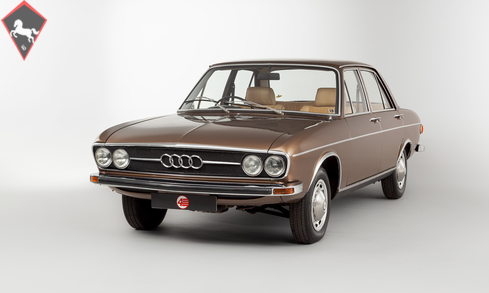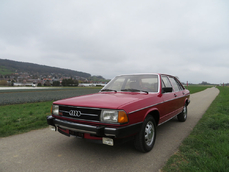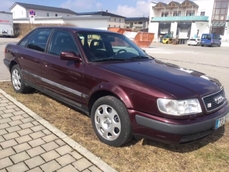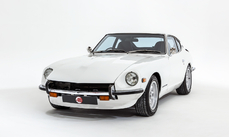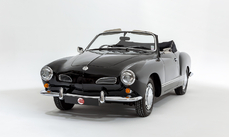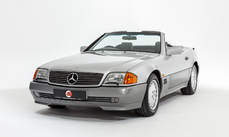Audi 100 GL 1973
General description :
Model History
In direct opposition and in secret to the Volkswagen board, the 1968 Audi 100 was born. An instant commercial success this Audi was the first in the series of front engine water-cooled cars from the Volkswagen group famous for its rear engine air-cooled models. The story goes like this: In 1965 Volkswagen purchased Auto Union (Audi, DKW, Horch, and Wanderer) from Mercedes as demand for the Beetle had outstripped Volkswagen's production capacity; Auto Union had a nearly-new production plant at Ingolstadt that was quickly converted for Beetle assembly. With poor sales of the DKW F102 and the new Audi F103 failing to prove itself in the market the Volkswagen boss Heinrich Nordhoff in the belief that the rear engine air-cooled layout was the future gave orders that no further Auto Union models (incl. Audi) be developed.
It was an engineer by the name of Ludwig Kraus that failed to share Nordhoff’s view and set about in secret developing the Audi 100. The first that Nordhoff learned about the project was the presentation of a production ready prototype! Thankfully for Audi fans, Nordhoff gave it the thumbs up. Shown to the press on 26th November 1968, the C1 platform Audi 100 was the company's largest car and spawned several variants, two and four door saloons and a fast back coupe.
The Audi 100 was named after the then engine output of 100ps. It surpassed the sales expectations of Volkswagen to the extent that additional production had to be set up at Volkswagen's own plant in Wolfsburg. By 1971 the 500,000th Audi was produced making it the most successful model in the company's history at the time.
The top of the range 100 GL was introduced in 1972 and featured the 1.9-litre engine formerly used in only the Fastback Coupe S.
Equipment
Agate Brown Metallic paintwork, Beige velour upholstery, 4-Speed manual gearbox, Three-spoke steering wheel, Wood inlays, Sharp cassette radio, Dash clock, Front seat belts, Front head restraints, Rear armrest, Heated rear window, Polished wheel embellishers, Cigar lighter, Front and rear ash trays, Spare wheel, Original document pack and service booklet.
Exterior
This has to be one of the finest Audi 100s we’ve seen. Sold by us to the current owner for his collection back in 2011, the car is even nicer than we remember. The period metallic brown paintwork presents to a lovely standard throughout with a deep shine, uniform colour, and sharp metallic flake all round. The original brightwork also appears in great shape with only minor age-related marking to report on close inspection. There are no signs of moisture ingress to any of the lights, and in the windows you’ll find a nice selection of original stickers, including one for the Ziebart rust-proofing treatment as applied to this car in 1976! All in all, a remarkably well preserved and highly original example with only 38k miles from new.
VIEWINGS WELCOME BY APPOINTMENT ONLY /// ADDITIONAL PHOTOS AVAILABLE UPON REQUEST
Interior
The cabin is a truly splendid place to be and is a real testament to the superb fit and finish Audi are so well known for; it’s also incredibly spacious for both front and rear occupants. The seats remain in magnificent order showing almost no signs of use, the door cards are free from any marks or scratches, and even the light-coloured carpets are still in fantastic condition. Everything appears exactly as it should for the mileage, the only real negative being a couple of very minor cracks atop the dash that could easily go unnoticed.
ENGINE & TRANSMISSION
The car feels incredibly tight on test. The 1.9-litre engine delivers its power smoothly via the four-speed manual ‘box that’s a pleasure to operate. The car fires into life first turn of the key and idles up to temperature without fuss. Lifting the bonnet, the engine bay presents in good solid condition and is still protected by the original Ziebart rust-proof coating – it may not be the prettiest sight but it has certainly kept any potential rust issues at bay.
Under current ownership the Audi has been part of an extensive private collection of classic cars. It has seen only very light use during this time but has always been properly stored and maintained accordingly by the collection’s caretaker. Since arriving at 4 Star we have had the car fully inspected for the new keeper’s peace of mind.
WHEELS, TYRES & BRAKES
The Audi sits on the correct 14-inch steels with the original domed hubcaps. Looking closely there is some expected curb marking to each of the wheel covers but overall they appear bright, still retaining a smart polished finish with the right Audi centre emblems. The wheels are shod in a matching set of Falken tyres that have seen next to no use.
History File
This lovely low mileage example was first registered in May 1973. It was supplied new by Cumnor Hill Service Station Limited, Oxford. Given the low mileage of 38k it’s no surprise that the Audi has spent most of its life in storage. The majority of the mileage was done before 1988, by which time the car had driven 37k miles. It was then safely tucked away and did not see the light of day again until 2001. The car has seen only the lightest of use since that time, covering little over 1,200 miles in the last 19 years. The History File is complete with plenty of old MOTs dating back to 1976 that help to verify the low mileage. The accompanying paperwork also includes the original Audi document wallet, owner’s manuals, stamped service booklet, invoices including the Ziebart rust-proofing treatment from 1976, and even the bill of sale from when the car sold to its second owner in 1975!
http://www.4starclassics.com/for-sale/audi-100-gl-for-sale/
1973 Audi 100 GL is listed sold on ClassicDigest in Kingsley by 4 Star Classics for £15995.
Car Facts
Car type : Car Make : Audi Model : 100 Model Version : GL Engine size : 1.9 Model Year : 1973 Sub type : Sedan Location : Hampshire
Sold
Seller Information
Sold
People who viewed this Audi 100 also viewed similar Audi listed at ClassicDigest
Other cars listed for sale by this dealer
About Audi
Audi Automobilwerke GmbH Zwickau was founded by August Horch and his partners. In August 1928, the majority of shares in Audiwerke AG were acquired by Jørgen Rasmussen,the owner of Dampf-Kraft-Wagen (DKW) In 1932, Audi merged with Horch, DKW, and Wanderer, to form Auto Union. Auto Union used the four interlinked rings as their logo, the Audi badge today, representing these four brands.After the war, Daimler-Benz had taken 100% holding in the Auto Union company by1959. By mid-sixties they had decided to sell to Volkswagen -a decision Mercedes must be regretting by now. Under VW control they took the two-stroke DKW F102, fitted it with a modern Mercedes designed four-stroke engine et voilá a new modern Audi had emerged. The rest, as they say, is history.
